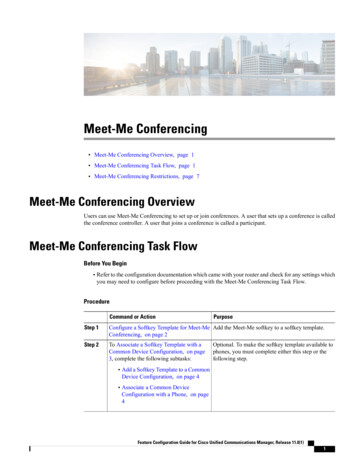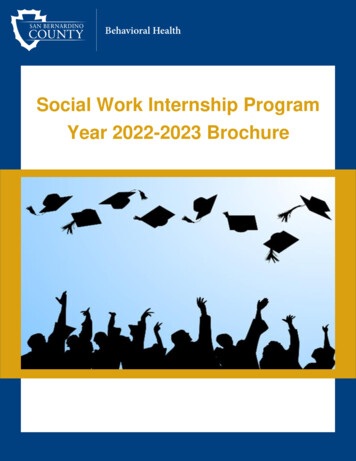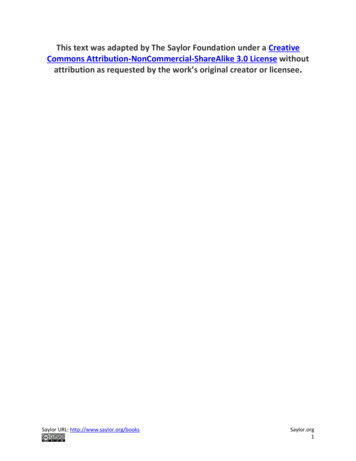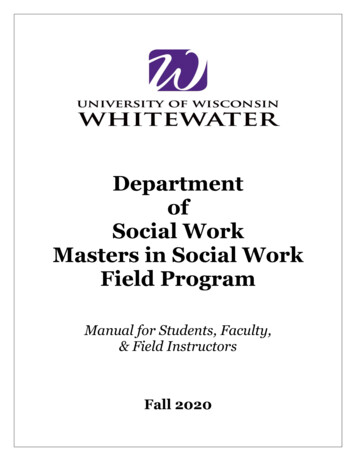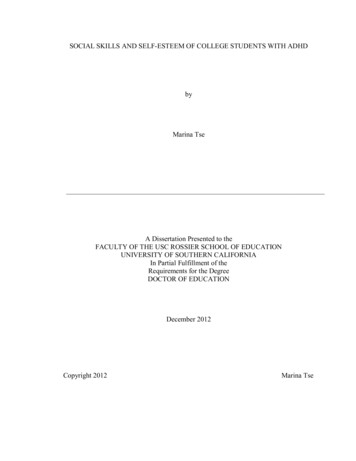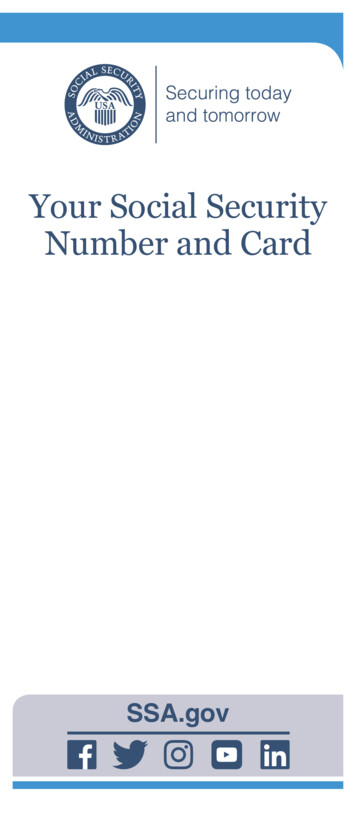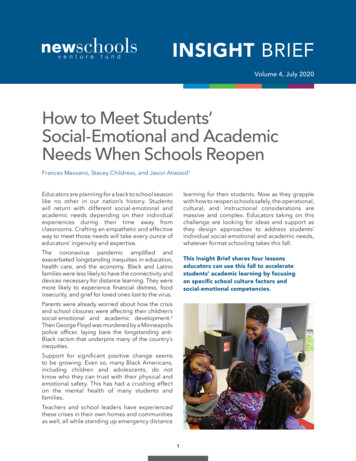
Transcription
INSIGHT BRIEFVolume 4, July 2020How to Meet Students’Social-Emotional and AcademicNeeds When Schools ReopenFrances Messano, Stacey Childress, and Jason Atwood1Educators are planning for a back to school seasonlike no other in our nation’s history. Studentswill return with different social-emotional andacademic needs depending on their individualexperiences during their time away fromclassrooms. Crafting an empathetic and effectiveway to meet those needs will take every ounce ofeducators’ ingenuity and expertise.learning for their students. Now as they grapplewith how to reopen schools safely, the operational,cultural, and instructional considerations aremassive and complex. Educators taking on thischallenge are looking for ideas and support asthey design approaches to address students’individual social-emotional and academic needs,whatever format schooling takes this fall.The coronavirus pandemic amplified andexacerbated longstanding inequities in education,health care, and the economy. Black and Latinofamilies were less likely to have the connectivity anddevices necessary for distance learning. They weremore likely to experience financial distress, foodinsecurity, and grief for loved ones lost to the virus.This Insight Brief shares four lessonseducators can use this fall to acceleratestudents’ academic learning by focusingon specific school culture factors andsocial-emotional competencies.Parents were already worried about how the crisisand school closures were affecting their children’ssocial-emotional and academic development.2Then George Floyd was murdered by a Minneapolispolice officer, laying bare the longstanding antiBlack racism that underpins many of the country’sinequities.Support for significant positive change seemsto be growing. Even so, many Black Americans,including children and adolescents, do notknow who they can trust with their physical andemotional safety. This has had a crushing effecton the mental health of many students andfamilies.Teachers and school leaders have experiencedthese crises in their own homes and communitiesas well, all while standing up emergency distance1
At NewSchools, we fund teams of educators whocreate new innovative district and charter schoolsaround the country. They are committed tobuilding strong school cultures and supportingstudents’ social-emotional and academic needsin an integrated way.3 In 2016, we partneredwith Transforming Education (TransformEd) on aresearch project to follow a common set of schoolculture and social-emotional indicators along withmeasures of academic growth and proficiency.4Our main purpose is to provide our schools withformative data and technical assistance to helpthem improve their work with students. We alsoshare insights from the data widely each year tohelp other educators learn from these schools.INSTRUCTIONALPLANNING RESOURCESTNTP: LearningAcceleration GuideInstruction Partners:Reentry ToolkitThese lessons are consistent with findings weshared in previous Insight Briefs in 2018 and 2019.5This year, we were able to conduct additionalanalysis with a longitudinal sample that revealedlarger effects on learning from two “power pairs.”6This analysis suggests that the relationship withacademic outcomes is larger when students:This year, we decided to narrow the lessons to afew things that have the strongest correlationsto academic outcomes. We know many thingsmatter. But if you are working with colleaguesto plan for the reopening of school—whether inperson, online, or some combination of the two—our data suggests that prioritizing a few aspects ofschool culture and social-emotional developmentwill create a supportive environment for yourstudents and reinforce your efforts to addresstheir academic needs. (See sidebar for suggestedinstructional planning resources.) believe their abilities and skills can grow witheffort and feel physically and emotionallysafe, or believe their abilities and skills can growwith effort and feel their teachers expect alot from them in terms of effort, persistence,and learning.Three clear findings from our 2018—2019 schoolyear data suggest that students learn morewhen they:A growing body of knowledge suggests thatschools can deliberately nurture school cultureand social-emotional learning that matters foracademic success.7 This brief describes thethree culture and social-emotional indicatorsand two power pairs most highly correlated withacademic results in schools we fund. We alsoshare examples from schools in our portfolioto provide educators with ideas for how to usethese findings in their own contexts. We choseto highlight schools in which Black and Latinostudents reported positive perceptions of theirsocial-emotional competencies and the cultureof their schools so the examples will be relevantto other schools that serve large numbers ofstudents of color. feel physically and emotionally safe, believe their abilities and skills can growwith effort, and develop ways to cope with their stress,emotions, feelings, and behaviors in differentsituations.2
INSIGHT 1Students who feel physically and emotionally safetend to do better academically.As schools reopen this fall, ensuring studentsfeel physically and emotionally safe will be moreimportant than ever. With schools shuttered formonths this past spring because they were notsafe for students’ and teachers’ health, manystudents and families are worried about returningto school buildings.8 At the same time, studentsof color, especially Black boys, are questioningwhom they can trust,9 a situation made moreacute by recent violence against Black Americans.Because our national teaching force remainsmore than 80 percent white,10 it is imperative thatthis aspect of student safety receives deep andfocused attention in reopening plans.links between culture, students’ social-emotionalcompetencies and math and reading outcomes.11This additional analysis revealed that all sevenschool culture factors we measure have aneffect on social-emotional learning.12 However,student safety is the only one with a statisticallysignificant positive effect on academic outcomesafter controlling for students’ social-emotionalcompetencies. When students rate their schoolhighly on our safety scale, we estimate thedifference in their academic performance tobe similar to moving from the 50th to the 56thpercentile on nationally normed assessments.How are teachers and school leaders creatinga sense of safety for students? Below are twoexamples of the approaches taken by schoolswith high safety ratings from students, followedby suggested resources and some questionsfor educators to consider as they plan for schoolreopening.For three years in a row, the extent to whichstudents report feeling physically and emotionallysafe in school is the strongest school culturefactor correlated with academic performance.This relationship is especially pronounced amongelementary school students. To get beyondbasic correlations, this year we also conductedmediation analyses to understand more deeply the3
INSIGHT 1At Statesmen Preparatory Academy for Boys inWashington D.C., establishing warm, caring, andtrusted relationships is central to their model sothat students feel emotionally safe and know thatthey belong. When adults see behaviors that arenot aligned with the school’s core values, theirfirst response is to tell a student, “You belong tome; you are not going to get suspended; you arenot going to leave school.” They then work outagreements for what to do differently movingforward. Students participate in a daily advisorysession where they learn social-emotional skills.And both students and teachers participate inmorning and end-of-day check-ins on how theyare feeling and whether they have what they needfor learning. The school provides mental healthsupport for its teaching staff, predominantly Blackmen, through Georgetown University, so theycan process their own trauma to better supportstudents.For three years in a row, the extent to which studentsreport feeling physically and emotionally safe in schoolis the strongest school culture factor correlated withacademic performance. This relationship is especiallypronounced among elementary school students.support in resolving difficult situations and peerhelpers know what to do, oftentimes without theassistance of an adult. Any student can apply to bea peer helper and selection is based on the strengthof applicants’ social-emotional competencies. Peerhelpers for the 2019-20 school year were selectedbefore distance learning began and students couldcontinue to reach out to them virtually for supportafter the school building closed.Helpful Resources: The National Association ofSchool Psychologists worked with many partnerorganizations to develop the Framework for Safeand Successful Schools, which includes guidanceon all aspects of student and school safety.14A supplemental guide for district and schoolleaders offers considerations and action steps forimplementation.15When Statesmen moved to distance learningin March, the team immediately focused onmaintaining strong relationships with students. Theymapped which faculty member had the strongestconnection with each student and assigned everystaff member five students to check in with duringplanned advisory sessions and by phone. Everystudent had at least two touch points daily from astaff member. The full school community continuedto come together online twice each day for morningmeetings and end of day check-ins, just as they didbefore the pandemic. Over 95 percent of studentslogged into learning activities every day duringdistance learning.Key Planning Questions for School Reopening: How have you communicated with studentsand their families about your plan to keepthem physically and emotionally safe? Howmight you create opportunities to hear andrespond to feedback from students andfamilies about the plan and how it is working? Does your school already have supportgroups and counseling services available oncampus? If not, how might you create themas part of your reopening plan? If so, did yourstudents access these resources and trustthe adults who administer them before thetransition to distance learning? If not, howmight you strengthen them going forward?At University Charter School in Livingston, Alabama,the team implemented the Peer Helpers programin the middle school grades.13 Peer Helpers isa national program that trains students in a setof core skills that empower them to assist fellowstudents with emotional, social, behavioral, andeducational challenges. At University, a group ofmiddle school students have been trained as peerhelpers and support other students when conflictor challenging situations arise. This has particularimpact in situations in which students do not feelcomfortable going to an adult. At any point in theday, students can go to peer helpers to ask for How might you gather student perceptions ofsafety and monitor changes in this data overtime? How will your team respond to trendsin the data?4
INSIGHT 2When students believe their abilities and skills can grow with effort,they are more likely to have higher learning outcomes.Getting better at something—whether playing thepiano or learning geometry—requires persistent,focused practice. Students are more likely to staymotivated and persist in their learning when theybelieve their knowledge and skills can improvewith effort and that mistakes are a learningopportunity, not a sign of failure.have experienced difficulty and frustration. At thesame time, educators are being asked to framethe reopening challenge as addressing “learningloss.” If this framing seeps into the explicit orimplicit messages students receive about theirlearning potential, it could have a negative effecton their belief that they can grow and sustain theirlearning with effort.With so much time away from school, manystudents are likely to need extra support fornurturing this belief, known as growth mindset.Though some will have had positive experienceswith distance learning, many other students willThis concept of growth mindset is widespreadin K-12 education.16 Some studies have yieldedmixed evidence about its importance and theeffectiveness of practices schools can use to fosterit.17 Yet for three consecutive years in our nationaldataset of innovative public schools, there is aconsistent pattern whereby students with strongperceptions of their growth mindset also achievesignificantly higher math and reading outcomes.Our findings this year reinforced the importanceof growth mindset. We estimate that studentswith well-developed perceptions of their owngrowth mindset experience a difference inacademic outcomes similar to moving from the50th to the 63rd percentile on nationally normedassessments. The magnitude of this finding islarge enough that the What Works Clearinghouserun by the Institute for Education Sciences wouldconsider it “substantively important.”18Below we describe some of the steps taken byschools whose students report particularly strongperceptions of their growth mindset. The examplesare followed by two suggested resources aboutfostering growth mindset and some questions toconsider as you develop your school reopeningplans.McClure Health Science High School is a districtpublic school in Gwinnett County, Georgia.Growth mindset is coded into the school’s DNAthrough structures and systems that help studentsand staff embody it daily. Through a weeklyadvisory session, students learn about growthmindset and how to challenge negative beliefsthat are self- or societally imposed. Advisorylessons are paired with weekly health scienceseminars in which students see growth mindset5
INSIGHT 2personified in representative role models whocome to the school to share their own journeysand experiences. Students hear directly fromhealth leaders about how persistent effortenables them to grow their abilities and skills andbecome more successful leaders.We estimate that students with well-developedperceptions of their own growth mindset experience adifference in academic outcomes similar to moving fromthe 50th to the 63rd percentile on nationally normedassessments.Growth mindset is a team sport at McClure. Theschool community believes that they are onlysuccessful when 100% of students are successful.As a result, the team recognizes students whohelp others grow. They celebrate growth mindsetdaily and feature students and staff on Instagramand other platforms when they show greatexamples of growth mindset.Helpful Resources: The Mindset Kit containsuseful guidance and tools for fostering growthmindset in students for both teachers andparents.19 The kit was developed by PERTS (Projectfor Education Research that Scales), an appliedresearch organization founded at StanfordUniversity that equips educators with practical,evidence-informed strategies to help all learnersthrive. Additional practices and interventionsare available in the Building Equitable LearningEnvironments Library.20Comp Sci High in the South Bronx also worksexplicitly to develop students’ growth mindset.Students spend the first week of ninth grade inan orientation where they are encouraged tothink deeply about how they might grow intothe learner they want to be. The Comp Sci teamthen helps students understand they can makedecisions, take risks, reflect on their choices, andmake adjustments as they grow.Key Planning Questions for School Reopening: How might you support teachers to try outand evaluate evidence-informed classroominterventions and practices for fosteringgrowth mindset, such as those suggested inour recommended resources?As they plan for school reopening in the fall, theteam intends to make it easier for students totrack, manage, and drive their learning throughfocused, directed effort. Comp Sci High will startthe fall with 27- to 33-day personalized “minimesters” for students. These will range from inperson, small-group sessions for students farbelow grade level to mostly distance learningfor students who have mastered 75 percent ofgrade-level competencies in the prior year. What steps can you take to create anenvironment in which teachers feelcomfortable reflecting on aspects of theirinstruction that might inhibit students’development of a growth mindset? Have you adopted a common framework tohelp educators understand growth mindsetthrough an equity lens?These mini-mesters will provide each studentwith support based on their specific academicand social-emotional needs that might haveemerged during distance learning. By reinforcingthat their abilities and skills can grow with focusedeffort and support, the team intends to helpeach student be ready to resume the full CompSci learning experience at the end of the minimesters.6
INSIGHT 3Students who develop ways to cope with stress, emotions,feelings, and behaviors in different situations are likely todo better academically.Learning to cope with stress is a normal part ofhealthy development. But excessive, prolongedstress can be debilitating. With so many studentsof color handling high levels of stress createdby the perfect storm of Covid-19 and persistentracism, it’s more important than ever that schoolshelp them develop ways to cope with their ownstress, emotions, feelings, and behaviors.As Zeta prepares for the reopening of theirschools, the team will shift to a shorter dailylesson (10 minutes) —regardless of whether theyreopen virtually or in-person— to ensure the focuson social-emotional competencies does not getdeprioritized.Grimmway Academy, in the California CentralValley, helps students set and work towardpersonal and academic goals using individualizedlearning plans (ILPs). Starting in 3rd grade,students develop their own ILP and reflect on theirprogress and habits to support their growth. EachILP identifies areas of strength and improvementand sets goals to address the areas of growth. Forexample, in a recent ILP, one student reflectedIn our schools, students’ perceptions of theirself-management skills are associated withhigher math and reading outcomes. Our analysisshows that when students rate them highly, thedifference in their learning is similar to movingfrom the 50th to the 59th percentile on nationallynormed assessments of reading and math.Below we share examples from two schools whosestudents report particularly strong perceptions oftheir self-management skills along with a toolkitwith resources for helping students developthem. We also provide some relevant questionsto consider as you develop your school reopeningplans.Indicators Most Highly CorrelatedWith Academic OutcomesAt Zeta Charter Schools, a network currentlyserving early elementary students in NewYork City, teachers conduct lessons on socialemotional learning twice a week and studentsshare how they have lived these lessons eachFriday during circle time. The first lesson of theyear is focused on “how to identify your feelings”,based on the belief that if students are unableto identify and name their feelings, they will notknow how to respond to them appropriately.Every classroom also has a “zen den” with sensorymaterials and other tools to support studentswhen they need additional help coping with theiremotions. Students also use “Mood Meters”,developed by the Yale Center for EmotionalIntelligence, to show their teachers and fellowstudents how they are feeling, which they canupdate throughout the day.7STUDENTSAFETYStudents’ perceptionof their physical andemotional safety at schoolGROWTHMINDSETThe belief that one’sabilities and skills cangrow with effortMANAGINGSELFThe ability to copeeffectively with stress,emotions, feelings andbehaviors in differentsituationsRIGOROUSEXPECTATIONSStudents’ perceptions ofhow much they are held tohigh expectations for theireffort, persistence, andlearning
INSIGHT 3on his difficulty focusing during an assessment.Using this reflection, the student created a planfor future assessments during the same timeblock and ways he could better prepare.Key Planning Questions for School Reopening: How might you encourage practices thathelp students identify and verbalize theirfeelings and emotions and develop multipletechniques for coping with them?22The ILPs help students develop self-awarenessof specific behaviors and actions that may besupporting their progress or creating roadblocks.In developing goals and reflecting on progress,students can see the direct correlation betweenthe actions they take and their progress in school. How might teachers support students insetting learning goals, developing plansfor reaching them, and reflecting on theirprogress? What is your district or school’s approach tosupporting those students and teachers whoreturn to school with heightened anxiety andmight need access to mental health services?Helpful Resource: Self-management Toolkit.21This toolkit was developed by TransformingEducation, our research partner on this project.It includes useful information about helpingstudents develop self-management skills andprofessional development resources for teachers.8
INSIGHT 4Two “Power Pairs” are associated with higher learning outcomes thanany single culture factor or social-emotional competency.Supportive and responsive learning environmentsthat equitably nurture student developmentinclude many interdependent elements. Untilthis year, our analysis helped us understandhow individual school culture factors and socialemotional competencies are correlated withacademic outcomes. Now that we have threeyears of data, our research partner was able totake a deeper look at some of the interactionsbetween multiple indicators.At Comp Sci High, students give the culturehigh marks, report strong social-emotionalcompetencies, and demonstrate outstandingacademic outcomes. They rate both power pairshighly, but because we provided examples ofgrowth mindset and student safety earlier inthis brief, the following example illustrates theschool’s approach to rigorous expectations in itsschool community.This longitudinal analysis revealed larger effectson learning from two “power pairs.” Our findingssuggest that the relationship with academicoutcomes is larger when students:POWER PAIRSGrowth Mindset is correlated more stronglywith better academic outcomes when pairedwith higher perceptions of two school culturefactors: safety and rigorous expectations believe their abilities and skills can grow witheffort and feel physically and emotionally safe, or believe their abilities and skills can grow witheffort and feel their teachers expect a lotfrom them in terms of effort, persistence, andlearning.IndicatorThe effect of rating these indicators highly intandem (i.e., growth mindset plus safety orrigorous expectations) is associated with evengreater academic outcomes than when studentsrate any single indicator highly.(at 1 SD from Mean)We estimate that students who rate the power pairof growth mindset and safety highly demonstrateadditional learning similar to moving from the50th to the 67th percentile on nationally normedassessments.Similarly, students who rate the power pair ofgrowth mindset and rigorous expectations highlydemonstrate a boost in learning outcomes thatwe estimate to be similar to moving from the50th to the 66th percentile on nationally normedassessments.Effect Size1 onPercentile RankMath and Reading in ProficiencyGrowthMindsetAlone.3463%GrowthMindset andSafety.4467%GrowthMindset andRigorousExpectations.4066%Effect sizes expressed as standard deviation from meanmath proficiency, with p .00119
INSIGHT 4The Comp Sci team emphasizes peertransparency about academic results alongwith an “error as opportunity” approach tolearning. This is embedded in the school’s fourCORE values: Courage (I approach obstaclesand challenges without fear), Ownership (I amresponsible for the success of my community),Responsibility (I am responsible for my actions)and Excellence (I push myself and my communityto stand out).Students who rate the power pair of growth mindsetand rigorous expectations highly demonstrate a boostin learning outcomes that we estimate to be similarto moving from the 50th to the 66th percentile onnationally normed assessments.the school’s peer tutoring program. Studentswith a certain GPA and demonstrated contentmastery can apply to serve as peer tutors. Thecombination of the advisory groups and peertutoring program has created a culture wherestudents are comfortable asking each other forhelp and holding each other accountable for theirindividual and collective academic progress.All students share their academic grades andgoals transparently with the other students intheir advisory group. Each advisory group sets acollective academic goal (“our collective GPA atthe end of the first trimester will be .”). Studentshold each other accountable for achievingtheir individual and collective goals throughPORTFOLIO CHARACTERISTICSPORTFOLIO COMPARISON58 Schools in 25 States and DCLow-income Students: 71%Black and Latino Students: 75%English Language Learners: 18%Special Education Students: 15%Black and Latino School Leaders: 43%Students’ learning growth exceedednational averages by an amount roughlysimilar to attending a school with averageresults for an additional 67 days in mathand 115 in reading.67 days in math115 days in readingGROWTHPROFICIENCY75% of our schools have a majority ofstudents meeting/exceeding growthgoals in math; 61% in reading67% of our schools outperform theirlocal districts on math proficiency;62% in reading75% in math61% in reading67% in math1062% in reading
How to Use These InsightsAbout This ProjectDiscussing individual school culture factorsand social-emotional competencies can seemreductive. Supportive and responsive learningenvironments have many interdependentattributes that work together to support studentlearning. Though the examples we sharedhighlight specific culture and social-emotionalindicators and power pairs, it is clear thatteachers in those schools take a holistic approachto supporting their students.In 2016, NewSchools launched a project inwhich our innovative school grantees use a setof common instruments to follow indicators ofschool culture, social-emotional competencies,and academic outcomes. Combined, these threecategories make up our expanded definition ofstudent success (EDSS).Since the 2016-2017 school year, we’ve partneredwith TransformEd to provide our schools withdata, evidence-based resources and technicalassistance to advance EDSS23. Our primary goalis to provide educators in our schools with theinformation and insights they need to support theacademic and social-emotional development ofeach of their students. We also want to advancethe state of practice, research, and policy morebroadly. That’s why we’re committed to sharingwhat we are learning as we go.We are not suggesting the indicators discussedin this piece are the only ones that matter. Rather,our aim is to highlight those that have persistentlyshown the strongest associations with academicoutcomes in our data, in hopes that educators willfind them useful as they plan for the upcomingback to school season. If part of your approachto reopening is to start as simple as possible andthen build on that initial foundation over time, thedata from our project offers useful insights aboutwhere you might begin.This brief is based on data collected and analyzedby TransformEd throughout the 2018-19 schoolyear, the third full year of the project. The full dataset includes 12,500 students across 46 schools in21 states and the District of Columbia. It includesstudent responses to our EDSS self-report surveyand performance on the NWEA MAP Growthassessment. TransformEd conducted severalanalyses to build an empirical foundation forour insights, including a mediation analyses ofa smaller longitudinal sample to estimate thepractical impact of rating select social-emotionalcompetencies and school culture factors highly.This statistical approach allows us to converteffect sizes into a metric that may be morefamiliar to educators, namely the percentile rankof students on nationally normed tests. For moreinformation about the methodological elementsof our analyses, please see our accompanyingtechnical memo or reach out to our Director ofResearch & Learning, Jason Atwood, at jatwood@newschools.org.It is important to note that these insights simplyprovide directional guidance. The findingsare correlations — statistically significant withmedium to large effect sizes — but correlations,nonetheless. The school vignettes are faithfulrenderings of practices in schools with highratings from students on culture and socialemotional indicators, yet they are anecdotal. Todate we have not been successful in attractingthe resources necessary to commission a mixedmethods study to determine connectionsbetween our EDSS indicators and certain schooldesign choices, interventions, and practices.Still, as educators face a back to school seasonlike no other, we believe our findings and thesnapshots of some of our schools can provideeducators across the country with ideas theycan use as they plan to reopen their schoolsand support the individual academic and socialemotional development of their students.11
KEY QUESTIONSKey questions for school reopening plansSTUDENTSAFETY How have you communicated with students and their familiesabout your plan to keep them physically and emotionally safe?How might you create opportunities to hear and respond tofeedback from students and families about the plan and how itis working? Does your school already have support groups and counselingservices available on-campus? If not, how might you createthem as part of your reopening plan? If so, did your studentsaccess these resources and trust the adults who administer thembefore the transition to distance learning? If not, how might youstrengthen them going forward? How might you gather student perceptions of safety and monitorchanges in this data over time? How w
students and reinforce your efforts to address their academic needs. (See sidebar for suggested instructional planning resources.) Three clear findings from our 2018—2019 school year data suggest that students learn more when they: feel physically and emotionally safe, believe their abilities and skills can grow with effort, and

